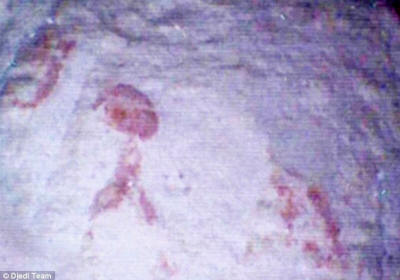|

by Rossella Lorenzi
May 26, 2011
from
Discovery Website
Written in red paint, the symbols may help Egyptologists figure out
why mysterious shafts were built into the pyramids.
A robot explorer sent through the
Great Pyramid of Giza has begun to
unveil some of the secrets behind the 4,500-year-old pharaonic
mausoleum as it transmitted the first images behind one of its
mysterious doors.
The images revealed hieroglyphs written in red paint that have not
been seen by human eyes since the construction of the pyramid.
The
pictures also unveiled new details about two puzzling copper pins
embedded in one of the so called "secret doors."

A composite of images
of the floor of the Great Pyramid is shown.
Red hieroglyphs are
visible.



Published in the Annales du Service Des Antiquities de l'Egypte
(ASAE), the images of markings and graffiti could unlock the secrets
of the monument's puzzling architecture.
"We believe that if these
hieroglyphs could be deciphered they could help Egyptologists
work out why these mysterious shafts were built," Rob
Richardson, the engineer who designed the robot at the
University of Leeds, said.
The study was sponsored by Mehdi Tayoubi
and Richard Breitner of project partners Dassault Systèmes in
France.
Built for the pharaoh Cheops, also known as Khufu, the Great Pyramid
is the last remaining wonder of the ancient world.
The monument is the largest of a family of three pyramids on the
Giza plateau, on the outskirts of Cairo, and has long been rumored
to have hidden passageways leading to secret chambers.
Archaeologists have long puzzled over the purpose of four narrow
shafts deep inside the pyramid since they were first discovered in
1872. Two shafts, extend from the upper, or "Kings Chamber" exit
into open air.
But the lower two, one on the south side
and one on the north side in the so-called "Queen's Chamber"
disappear within the structures, deepening the pyramid mystery.
Widely believed to be ritual passageways
for the dead pharaoh's soul to reach the afterlife, these
8-inch-square shafts remained unexplored until 1993, when German
engineer Rudolf Gantenbrink
sent a robot through the southern shaft.
After a steady climb of 213 feet from the heart of the pyramid, the
robot came to a stop in front of a mysterious limestone slab adorned
with two copper pins.
Nine years later, Hawass explored the southern shaft on live
television. As the world held its breath, a tomb-raiding robot
pushed a camera through a hole drilled in the copper pinned door -
only to reveal what appeared to be another door.
The following day, Hawass sent the robot through the northern shaft.
After crawling for 213 feet and navigating several sharp bends, the
robot came to an abrupt halt in front of another limestone slab.
As with the Gantenbrink door, the stone was adorned with two copper
pins.
"I dedicated my whole life to study
the secrets of the Great Pyramid. My goal is to finally find out
what’s behind these secret doors," Zahi Hawass, Egypt's Minister
of State for Antiquities Affairs, told Discovery News in a
recent interview.
In the attempt to solve the mystery,
Hawass established the
Djedi project, a joint international-Egyptian
mission, which he named after the magician who Khufu consulted when
planning the layout of this pyramid.
"I selected the Djedi team during a
competition that I coordinated to pick the best possible robot
to explore the shafts in the Great Pyramid," Hawass said.
The winning robot, designed by Leeds
University, has indeed gone further than anyone has ever been before
in the pyramid.
The project began with the exploration of the southern shaft, which
ends at the so called "Gantenbrink’s door."
The robot was able to climb inside the walls of the shaft while
carrying a "micro snake" camera that can see around corners.
Unlike previous expeditions, in which camera images were only taken
looking straight ahead, the bendy camera was small enough to fit
through a small hole in a stone "door," giving researchers a clear
view into the chamber beyond.
It was at that time that the camera
sent back images of 4,500-year-old markings.
"There are many unanswered questions
that these images raise," Richardson told Discovery News.
"Why
is there writing in this space? What does the writing say? There
appears to be a masonry cutting mark next to the figures: why
was it not cut along this line?" Roberston wondered.
The researchers were also able to
scrutinize the two famous copper pins embedded in the door to the
chamber that had only ever been glimpsed from the front before.
"The back of the pins curve back on
themselves. Why? What was the purpose of these pins? The loops
seem too small to serve a mechanical purpose," Richardson said.
The new information dismisses the
hypothesis that the copper pins were handles, and might point to an
ornamental purpose.
"Also, the back of the door is
polished so it must have been important. It doesn't look like it
was a rough piece of stone used to stop debris getting into the
shaft," project mission manager Shaun Whitehead, of the
exploration company Scoutek UK, said.
The Djedi robot is expected to reveal
much more in the next months.
The device is equipped with a unique range of tools which include a
miniature "beetle" robot that can fit through a 19 mm diameter hole,
a coring drill, and a miniaturized ultrasonic device that can tap on
walls and listen to the response to help determine the thickness of
the stone.
The next step will be an investigation of the chamber's far wall to
check whether it is another door, as suggested in the 2002 live
exploration, or a solid block of stone.
"Then we are going to explore the
northern shaft," Richardson said.
The team has committed to completing the
work by the end of 2011.
A detailed report on the findings is
expected to be published in early 2012.
|




